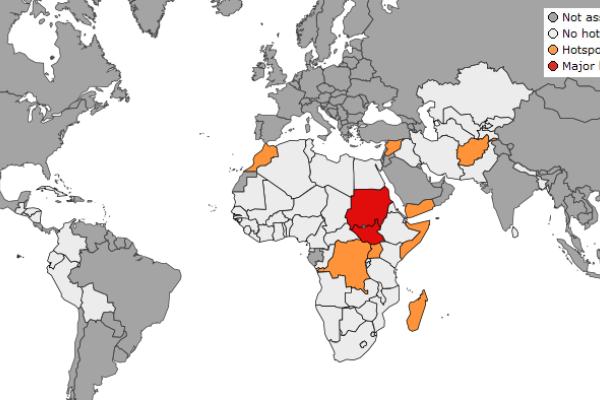
Executive summary
Spring 2025 has been marked by a severe rainfall deficit in north-western Europe, with the Benelux countries, northern France, Germany, western and southern Poland, and Sweden experiencing one of the driest springs on record. This has raised concerns about crop yield expectations, particularly for winter and spring crops, as soil moisture levels have dropped to critically low levels. Actual impacts have been limited so far, thanks to cool nights and moderate daytime temperatures.
Meanwhile, the Iberian Peninsula, Italy and Greece have benefited from abundant rainfall, resulting in improved growing conditions and positive yield expectations, particularly in Spain and Portugal, where yields are forecast to be 15–20 % above the five-year average.
Sowing campaigns for grain maize, soybean and spring barley are largely complete across Europe, but delayed in Portugal and northern Spain due to excessive rainfall. Nevertheless, early crop development is proceeding well.
Irreversible yield reductions are expected for western Maghreb, eastern Ukraine and Cyprus. In western Maghreb, a severe rainfall deficit during autumn and winter has caused crop failures in parts of Morocco and western Algeria. Similarly, in eastern Ukraine, persisting dryness has lowered the yield potential. In Cyprus, an early end to the winter season, combined with dry spells and cold waves, has led to lower yield expectations. Meanwhile, the concerns raised for Bulgaria and Romania in the April bulletin have been lifted due to adequate rainfall since.
Areas of concern
Severe water deficit in north-western Europe challenges farmers and puts crop yields at risk
In the Benelux countries, northern France, Germany, western Poland and Sweden, the spring of 2025 was one of the driest in our records (since 1991), with most regions receiving only 0–50 % of the normal precipitation for the period analysed. Winter and spring crops are still in fair condition due to moderate temperatures; nevertheless, the first signs of drought impacts are becoming apparent, particularly as winter crops approach flowering. Where possible, farmers are irrigating crops, but winter and spring crops are likely to continue to suffer from limited rainfall and above-average temperatures, forecast for the coming weeks. In contrast, summer crops are less affected by the dry conditions, as their water demand is still relatively low, and field operations have benefited from the dry period. In Belgium, the western regions (West-Vlaanderen and Oost-Vlaanderen) are the most affected, and the impacts of drought are already visible. In Germany, negative impacts on crops have not yet been significant; however, they are likely to become more apparent in the coming weeks, which are projected to bring only limited precipitation, mostly in the north.
Dry weather causes concern in central and eastern Europe
There are concerns about dry weather in central (Poland, Czechia, Slovakia) and south-eastern Europe (Romania), although the rainfall deficit is less severe than in northern-western Europe, and substantial rain is forecast (Romania).
Early end to winter season in Cyprus: low yield expectations ahead
In Cyprus, the winter season has ended earlier than usual due to limited availability of water for crops in an already below-average growing season, resulting in lower-than-average yield expectations.
Excessive moisture and pest pressure cause concern in Tunisia
Minor concerns associated with overly wet conditions and pest pressure have been observed in Tunisia.
Below-average yield expectations in drought-stricken regions (eastern Ukraine, Türkiye and western Maghreb)
The impacts observed in eastern Ukraine, Türkiye and western Maghreb are attributed to a dry winter and/or spring period, resulting in unfavourable growing conditions for winter crops. Consequently, the yield expectations in those regions are below the five-year average.
Further agricultural information
Subscribe to the JRC MARS Bulletin | (Unsubscribe from your profile page)
JRC MARS (Monitoring Agricultural Resources) Bulletins
For comprehensive agricultural insights for Europe, explore the JRC AGRI4CAST website, which offers a wealth of information, tools, data and tutorials, including:
- JRC MARS Bulletins: Receive monthly analyses on crop growth conditions and yield forecasts for the EU and neighbouring countries.
- JRC MARS Explorer: Access over 2000 high-resolution maps and graphs detailing recent weather conditions and crop-growth progress.
- AGRI4CAST Resources Portal: Utilise freely available datasets and software developed by AGRI4CAST for public use.
- Crop Forecasting Videos: Engage with an educational collection of videos that provide an overview of crop monitoring and yield forecasting activities.
For global agricultural insights, visit the JRC’s ASAP (Anomaly Hotspots of Agricultural Production) website to access the latest information on global agricultural production hotspots in countries at risk of food insecurity.
Links to related topics
- Droughts (CEMS European Drought Observatory | the latest drought report)
- Soil (EU Soil Observatory | the latest EUSO newsletter)
Details
- Publication date
- 26 May 2025
- Author
- Joint Research Centre
- JRC portfolios 2025-27



